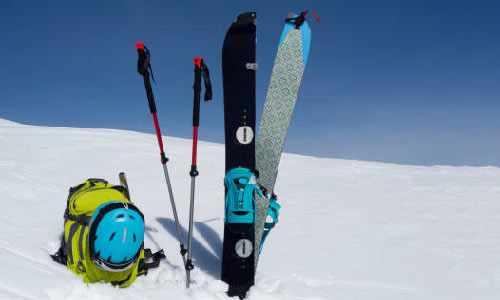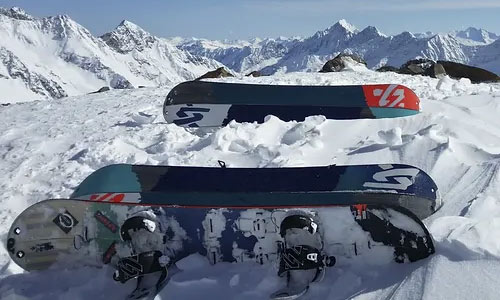Everything about Splitboarding
If you have a keen interest in splitboarding and are looking for something to help you out, this article is the perfect guide for you. I have worked with the ISIA and ISDT Qualified Snowboard Instructor, Owain George of TDC Snowboarding, and hence, can give you some much-needed tips to start your journey.
Safety First
Activities like these include high risks when attempted in winters and can even cause death.
Thus, it makes it important for a splitboarder to take all safety measures possible
- Hire a guide to teach you all the tricks and techniques of skateboarding.
- Take up an avalanche safety course.
- Practice the drills taught in the course regularly.
- Don’t go splitboarding with a person unaware of avalanche safety.
- Cancel your plan if you are not 100% confident about it.

What is it?
In splitboarding, you travel in all directions of the snow terrain- from flat to uphill terrains with the help of skis and downhill with the help of a snowboard. Splitboarding gives you the chance to travel through the backcountry terrain which is otherwise accessible only with helicopters or snowmobiles.
What does a splitboard look like?
A splitboard is a snowboard that splits into half and forms skis for the uphill tracks. For the downhill tracks, the skis can be connected back together to form a board for the rider. This is possible with the help of special bindings that help convert the snowboard to ski gear and vice versa.
How does it work?
Splitboarding is possible only with the help of skins, which are sticky sheets of nylon or mohair that are attached to the bottom of your skis.
How to do splitboarding?
A splitboarder needs a few extra skills apart from being an advanced snowboarder.
Splitboard for touring
Converting the splitboard can become a task while touring and so, here are some pointers on how to quickly convert it:
- Disconnect the bindings.
- Undo the tail and nose split hooks and part the board.
- Put the skis down to see that the outer edges are parallel to each other.
- Attach the ski bindings and fix the slider pin to the touring brackets.
Putting skins on splitboard
- Place your skis into the snow with the bottoms preferably facing the sun.
- Identify the correct skin for the correct ski.
- Peel off a part of the ski and hook it on the ski’s front end.
- When the positioning is correct, pull the rest of it.
- Flatten the skins and make sure that the ski’s edges are not covered by the skins.
Splitboard Skinning
The uphill travel on your splitboard is called splitboard skinning. It is similar to cross-country skiing. You need to glide across the snow without lifting much of the ski off the snow.
Moving uphill on a splitboard
One can traverse uphill either by switchbacks/ zig-zags with the help of kick turns or by lifting the heel higher on your binding.

Things to pack for splitboarding
You will require a 25-35 litre hiking day pack which should include the following things:
Safety gear- shovel, phone, charger, rescue service contacts, first aid kit, etc.
Clothing- sunglasses, hat, gloves, etc.
Navigation tools- map, compass/GPS.
Essentials- snacks, sunscreen, water, headlamp.
Other gears- poles, skins, crampons, repair kits, etc.
Prepping yourself
Weather- Getting a heads up about the weather can be a big saviour if they are any warnings for blizzards, etc. so before you head out, make sure you are keeping a tab of the weather conditions and prep yourself accordingly.
Avalanches- it is best to get yourself hooked on an avalanche forecast app to be up to date with the situation of the area where you are planning to splitboard.
Fitness- Being in shape before your journey is very much important. You must train yourself in cardio fitness and endurance, some strength, balance, and mobility training, so that you are fully prepared for the obstacles.
Planning your route- this helps in honing your navigation skills and knowing about rescue services or stations that are nearby the area.
Splitboarding is a magical experience that one should at least try once with proper knowledge and safety.
Categories
- Sport (28)
- Product Reviews (3)
- Team Outdoor Look (7)
- Mike Wild (2)
- Mike Payton (2)
- Suse Hammond-Pears (3)
- Snowboarding (12)
- Latest Offers (105)
- Shop Talk (1)
- Competitions (7)
- Walking (413)
- Lifestyle Fashion (8)
- Travel (86)
- Kit Guides (176)
- Workwear Clothing (6)
- Safety Workwear (4)
- Health/Fitness (289)
- Skiing (91)
- Great Outdoors (1316)
- Cycling (92)
- January 2025
- December 2024
- November 2024
- October 2024
- September 2024
- August 2024
- July 2024
- June 2024
- May 2024
- April 2024
- March 2024
- February 2024
- January 2024
- December 2023
- November 2023
- October 2023
- September 2023
- August 2023
- July 2023
- June 2023
- May 2023
- April 2023
- March 2023
- February 2023
- January 2023
- December 2022
- November 2022
- October 2022
- September 2022
- August 2022
- July 2022
- June 2022
- May 2022
- April 2022
- March 2022
- February 2022
- January 2022
- December 2021
- November 2021
- October 2021
- September 2021
- August 2021
- July 2021
- June 2021
- May 2021
- April 2021
- March 2021
- February 2021
- January 2021
- December 2020
- November 2020
- October 2020
- September 2020
- August 2020
- July 2020
- June 2020
- May 2020
- April 2020
- March 2020
- February 2020
- January 2020
- December 2019
- November 2019
- October 2019
- September 2019
- August 2019
- July 2019
- June 2019
- May 2019
- April 2019
- March 2019
- February 2019
- January 2019
- December 2018
- November 2018
- October 2018
- September 2018
- August 2018
- July 2018
- June 2018
- May 2018
- April 2018
- March 2018
- February 2018
- January 2018
- December 2017
- November 2017
- October 2017
- September 2017
- August 2017
- July 2017
- June 2017
- May 2017
- April 2017
- March 2017
- February 2017
- January 2017
- December 2016
- November 2016
- October 2016
- September 2016
- August 2016
- July 2016
- June 2016
- May 2016
- April 2016
- March 2016
- February 2016
- January 2016
- December 2015
- November 2015
- October 2015
- September 2015
- August 2015
- July 2015
- June 2015
- May 2015
- April 2015
- March 2015
- February 2015
- January 2015
- December 2014
- November 2014
- October 2014
- September 2014
- August 2014
- July 2014
- June 2014
- May 2014
- April 2014
- March 2014
- February 2014
- January 2014
- December 2013
- November 2013
- October 2013
- September 2013
- August 2013
- July 2013
- June 2013
- May 2013
- April 2013
- March 2013
- February 2013
- January 2013
- December 2012
- November 2012
- October 2012
- September 2012
- August 2012
- July 2012
- June 2012
- May 2012
- April 2012
- March 2012
- February 2012
- January 2012
- December 2011
- November 2011
- October 2011
- September 2011
- August 2011
- May 2010
- April 2010
- March 2010
- February 2010
- January 2010
- November 2009
- October 2009
- September 2009


Submit a Comment